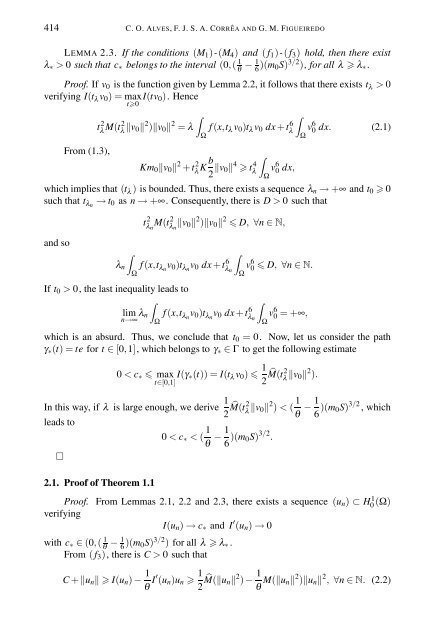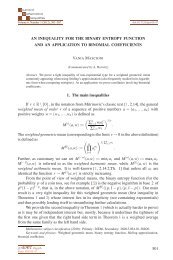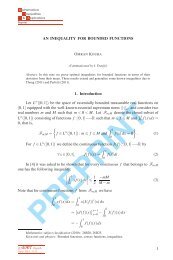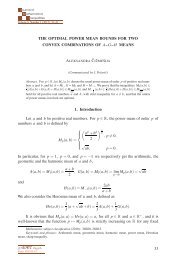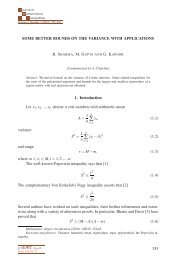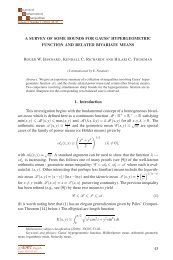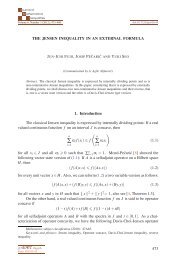On a class of nonlocal elliptic problems with critical growth - Ele-Math
On a class of nonlocal elliptic problems with critical growth - Ele-Math
On a class of nonlocal elliptic problems with critical growth - Ele-Math
You also want an ePaper? Increase the reach of your titles
YUMPU automatically turns print PDFs into web optimized ePapers that Google loves.
414 C. O. ALVES,F.J.S.A.CORRÊA AND G. M. FIGUEIREDO<br />
LEMMA 2.3. If the conditions (M1)-(M4) and ( f1)-( f3) hold, then there exist<br />
λ∗ > 0 such that c∗ belongs to the interval (0,( 1<br />
θ<br />
− 1<br />
6 )(m0S) 3/2 ), for all λ λ∗ .<br />
Pro<strong>of</strong>. If v0 is the function given by Lemma 2.2, it follows that there exists tλ > 0<br />
verifying I(tλ v0)=max<br />
t0 I(tv0). Hence<br />
t 2 λ M(t2 λ v0 2 )v0 2 <br />
<br />
= λ<br />
dx. (2.1)<br />
f (x,tλ v0)tλ v0 dx+ t<br />
Ω<br />
6 λ v<br />
Ω<br />
6 0<br />
From (1.3),<br />
Km0v0 2 + t 2 b<br />
λ K<br />
2 v0 4 t 4 <br />
λ v<br />
Ω<br />
6 0 dx,<br />
which implies that (tλ ) is bounded. Thus, there exists a sequence λn → +∞ and t0 0<br />
such that tλn → t0 as n → +∞. Consequently, there is D > 0 such that<br />
and so<br />
t 2 λn M(t2 λn v0 2 )v0 2 D, ∀n ∈ N,<br />
<br />
λn f (x,tλn Ω<br />
v0)tλn v0 dx+ t 6 <br />
λn<br />
v<br />
Ω<br />
6 0<br />
If t0 > 0, the last inequality leads to<br />
<br />
lim<br />
n→∞ λn<br />
f (x,tλn Ω<br />
v0)tλn v0 dx+ t 6 λn<br />
D, ∀n ∈ N.<br />
<br />
Ω<br />
v 6 0 =+∞,<br />
which is an absurd. Thus, we conclude that t0 = 0. Now, let us consider the path<br />
γ∗(t)=te for t ∈ [0,1], which belongs to γ∗ ∈ Γ to get the following estimate<br />
0 < c∗ max<br />
t∈[0,1] I(γ∗(t)) = I(tλ v0) 1<br />
2 M(t 2 λ v0 2 ).<br />
In this way, if λ is large enough, we derive 1<br />
2 M(t 2 λ v0 2 ) < ( 1 1<br />
−<br />
θ 6 )(m0S) 3/2 ,which<br />
leads to<br />
0 < c∗ < ( 1 1<br />
−<br />
θ 6 )(m0S) 3/2 .<br />
<br />
2.1. Pro<strong>of</strong> <strong>of</strong> Theorem 1.1<br />
Pro<strong>of</strong>. From Lemmas 2.1, 2.2 and 2.3, there exists a sequence (un) ⊂ H1 0 (Ω)<br />
verifying<br />
I(un) → c∗ and I ′ (un) → 0<br />
<strong>with</strong> c∗ ∈ (0,( 1 θ − 1 6 )(m0S) 3/2 ) for all λ λ∗ .<br />
From ( f3), thereisC > 0 such that<br />
C + un I(un) − 1<br />
θ I′ (un)un 1<br />
2 M(un 2 ) − 1<br />
θ M(un 2 )un 2 , ∀n ∈ N. (2.2)


